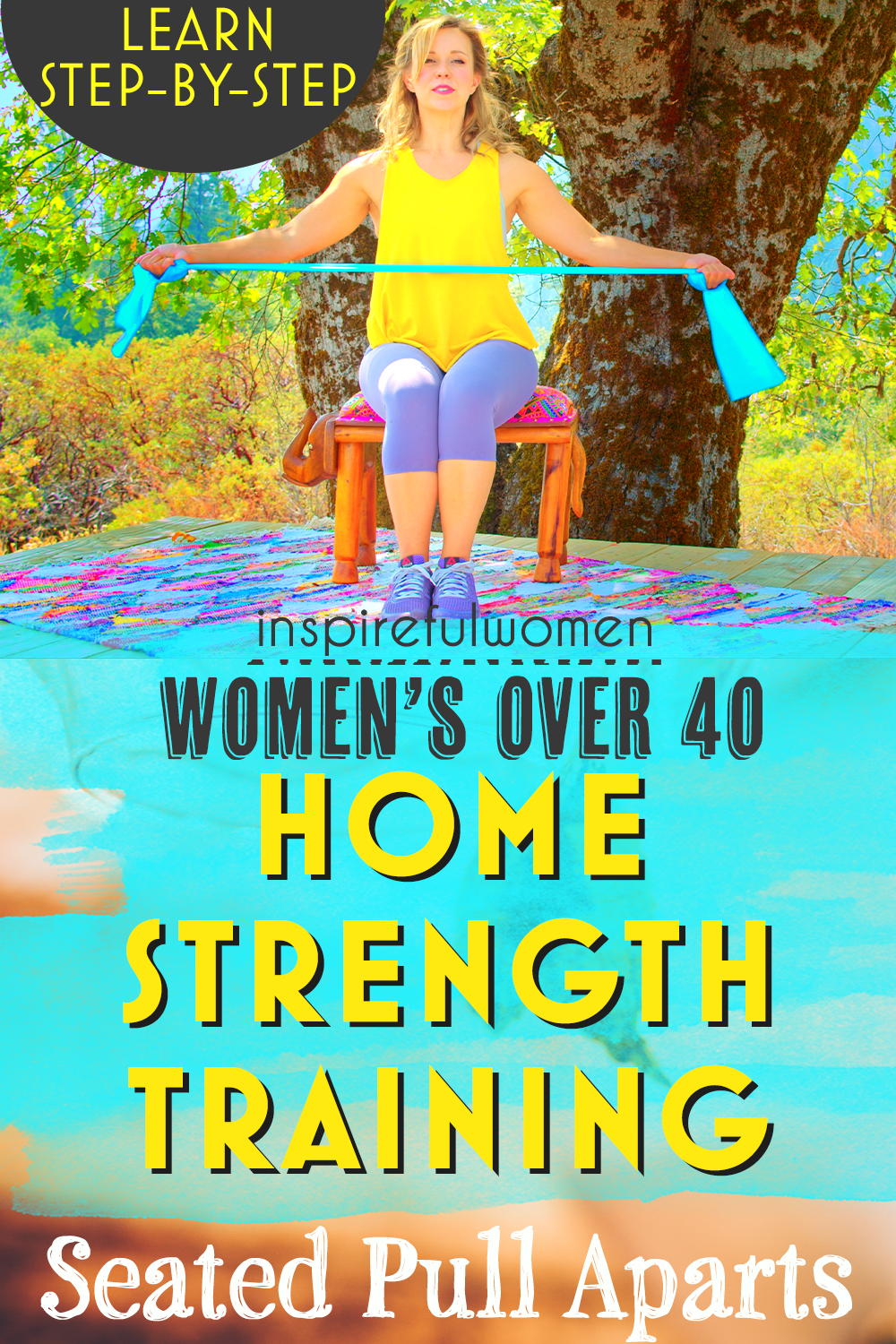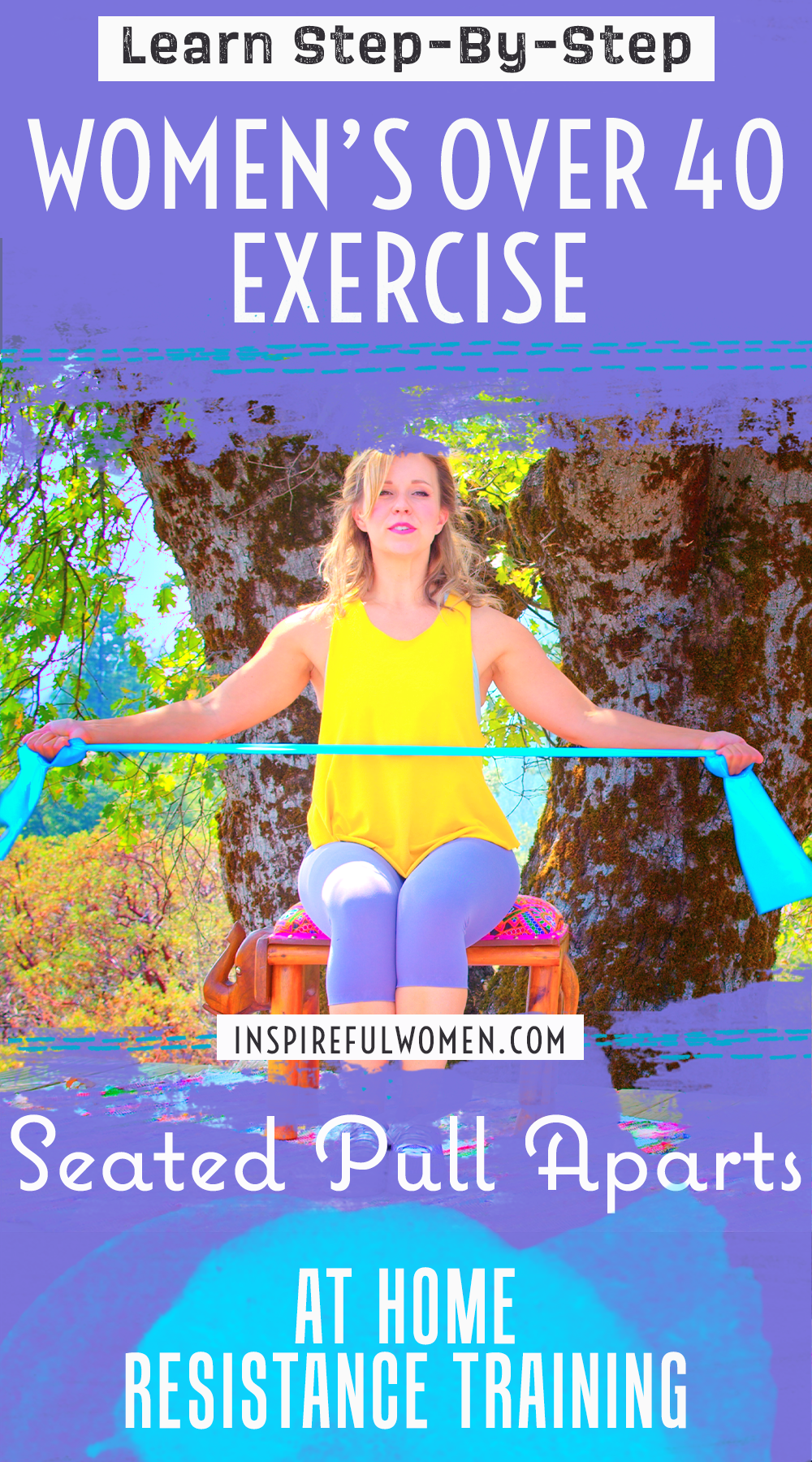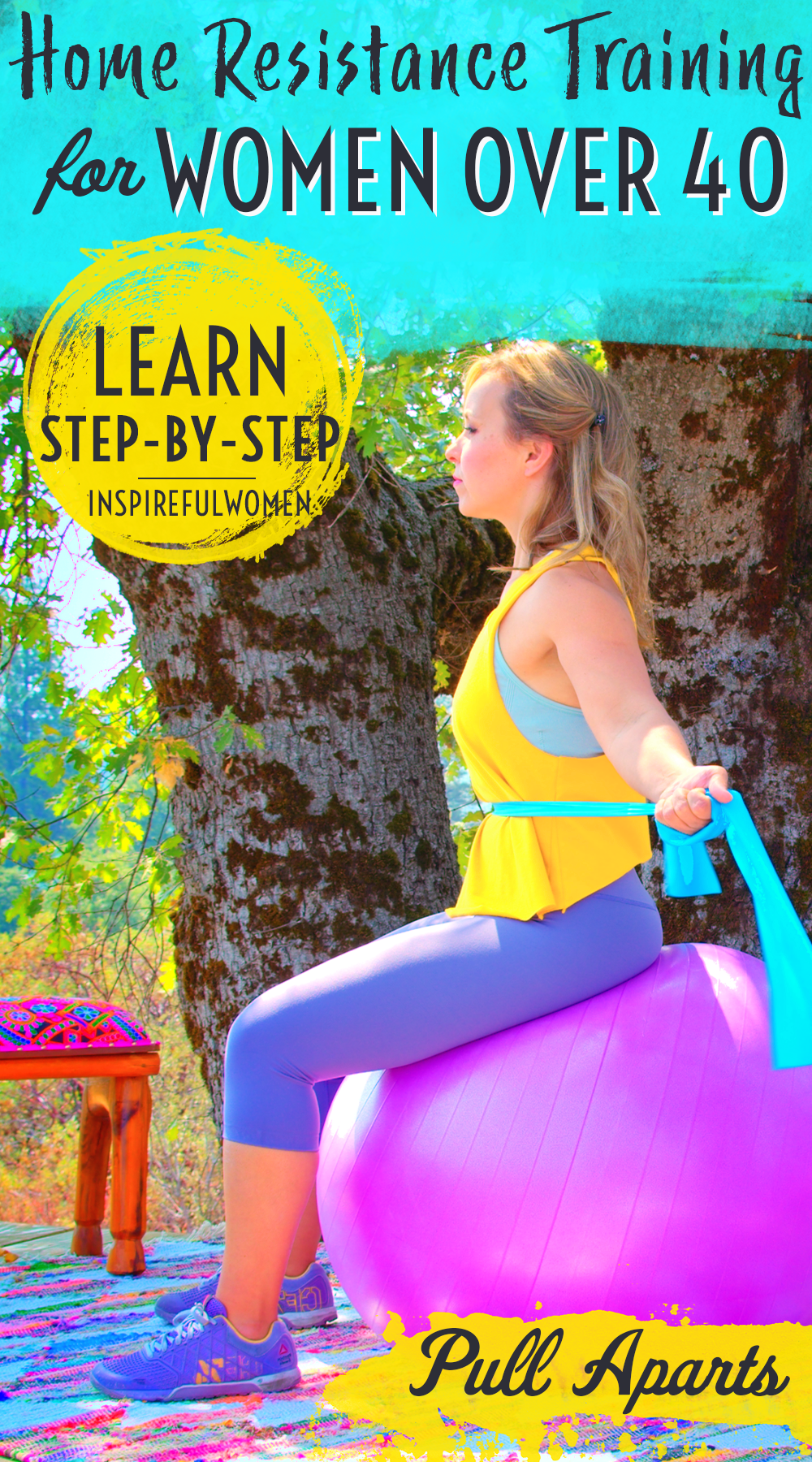Band Pull Aparts
How to Do Band Pull Aparts - Shoulder Activation & Upper Back Exercise | In-Depth Guide [VISUAL LEARNERS] Beginner
Proper Form, Common Mistakes, Variations + Easier & Harder | Home Resistance Training
WHAT DO YOU WANT TO SEE?
QUICK DEMO
QUICK DEMO
MUSCLES THIS WORKS
MUSCLES
MAIN MUSCLES WORKED IN Resistance BAND PULL APARTS
UPPER BACK: Middle & Lower Trapezius, RHOMBOIDS & DELTOIDS
OTHER MUSCLES WORKED:
- Rotator cuff (supraspinatus, infraspinatus, subscapularis, teres minor)
- Latissimus dorsi
- Upper trapezius
- Serratus anterior
- Pectoralis major and minor
- Subclavius
- Coracobrachialis
- Biceps
- Triceps
WHAT WE'RE DOING TODAY
WHAT & WHY
BENEFITS OF TRAINING THE MIDDLE AND LOWER TRAPEZIUS
WHAT
WHAT WE'RE DOING TODAY
ALL WE'RE DOING:
This is a simple hands together, hands apart move.
Band Pull Aparts is a nice one to do daily to work on improving posture, especially as a little break from seated activities or activities done in front of the body. The band pull aparts will lengthen the muscles on the front of the chest and work the muscles on the upper back and shoulder.
This exercise will work the muscles used to support upright posture. Typical problems with posture, or poor posture, include rounded back and shoulders and arms rotated inward - rolled in towards the chest. Poor posture has been known to cause neck, shoulder, rib, and back pain.
This exercise works most of the muscles that move and stabilize the shoulder blade as the arm moves. It is one of the few exercises that can be done daily if you want! Who am I kidding? Generally speaking, most of us aren't looking for reasons to do an exercise more frequently. But there ya go.
WHY BOTHER DOING IT?
WHY
WHY DO WE EVEN CARE?
Trapezius. What an odd name right? Where are these muscles even locate? They are right here my friend.
They're called "Traps" for short, because it just sounds too high-falutin to go around saying "I spent a considerable amount of time training my upper trapezius this day and plan to again on the morrow..."
When you think traps, you want to think, shoulder blade. The traps are central to the movement of the shoulder blade, or scapula.
THE MUSCLES ON OUR BACKSIDE GET IGNORED A LOT
The muscles on the back of the upper body are frequently overlooked in exercise programs. A lot of time is spent on exercises that involve lifting the arms up, pushing them forward, pulling them down. It is important to include exercises that target the muscles of the back of the body in order to balance out the exercises that focus on the muscles on the front of the body.
WHO KNEW SHOULDER BLADE MUSCLES WERE SO IMPORTANT?
Some of the most important muscles of the upper body are the muscles that attach to the shoulder blades. They're not really called "shoulder blade muscles" - that's just me giving them a more down-to-earth name for this movement.
These muscles are responsible for keeping the shoulders healthy, the ability to move your arm through its full range, and hold you in an upright posture. Overworking the muscles on the front of the body and underworking the muscles on the back of the body can lead to a stooped posture, and upper back, neck, and shoulder pain.
It is extremely rare that we only use one muscle at a time. Most movements involve many muscles working in coordination. This is especially true for movements of the arm. The main job of the shoulder is to move and position the hand. Moving the arm involves coordination between the arm and the shoulder blade. This exercise is good for targeting the muscles that control the movements of the arm and the shoulder blade and training them to work together for healthy arm movement.
EVERYDAY LIFE
EVERYDAY LIFE &
MUSCLE FUNCTION
HOW WE USE OUR Middle & Lower Trapezius IN EVERYDAY LIFE
1. REACHING BEHIND THE BODY
- Tending a kid in the back seat
- Reaching into the back pocket
- Bringing the arm back to throw a ball (overhand)
2. PULLING
- Pulling a car door shut
- Pulling a refrigerator door open
3. ROTATING THE UPPER ARM SO THAT THE SOFT UNDERSIDE IS FACING FORWARD AND/OR UP (EXTERNAL ROTATION)
- Reaching the back of your head for washing, brushing your hair
- Pulling a shirt off over your head
- Reaching the top of a zipper
- Scratching your upper back
- Turning your outstretched arm with the palm up (need shoulder external rotation and forearm supination)
- Receiving change in the palm of the hand
4. WORKS WITH THE FRONT & MIDDLE FIBERS OF THE DELTOID TO STABILIZE THE SHOULDER JOINT DURING ALL ARM MOVEMENTS.
- Improves the ability to lift and carry heavy objects (the arm has a stable base to work off of).
- Injury prevention
STARTING POINTERS
Starting Pointers
Band pull aparts are exactly as they sound - you pull your hands apart to stretch the band.
The arms are lifted up with each set to activate the muscles that move and stabilize the shoulder blade and also to target the shoulder muscles differently.
The arms are held rotated up - soft underside of upper arm facing up (external rotation of the shoulder), this helps to counter the forward rotation of the upper arm seen in poor posture.
HOW TO DO THE EXERCISE
LOOKS
HOW BAND PULL APARTS SHAPE OUR BODY
Good posture, strong and well-defined shoulders and upper back.
PROPER FORM
PROPER FORM: BAND PULL APARTS
EQUIPMENT, SETS & REPS
EQUIPMENT
Main set (3: Light/Med/Heavy)
X-Heavy Band (I recommend getting this too if you plan to use resistance bands frequently).
SUGGESTED STARTING WEIGHT FOR WOMEN:
Light to moderate resistance bands
SETS & REPS:
3 sets of 8 -10: can be done 5-7 days per week.
PACE:
Moderate speed - 1 rep per second.
BODY POSITION
BODY POSITION FOR BAND PULL APARTS
ARMS: Lifted to the front at belly button level. The elbows are straight but soft or slightly bent if it is more comfortable. Hands shoulder-width or wider.
FEET: Shoulder width apart, toes pointed forward.
BODY STANCE: Knees slightly bent, neutral spine (includes neck), sternum lifted, chest wide to begin. Shoulder blades down your back.
HAND: Hold one end of the band in each hand with a supinated grip: palms facing up. Band taut - but you be sure that you can get your elbows behind your body - if not then loosen up on the band a little. Hands shoulder-width or wider.
NECK: Neutral and relaxed.
HOW TO DO
HOW TO DO BAND PULL APARTS
CUE: The movement is done at three different levels - the arms move up with each set.
Pull the band apart so that your hands move out to the sides. You should be able to feel your shoulder blades moving closer and closer together as your arms move back.
Return the arms to the starting position for the next rep. After completing 8-10 reps at this level, move your arms up so that your hands are at chest level. Complete 8-10 reps.
Move your hands up to eye level. This movement will be like an inverted V motion, the hands start at eye level and move down to mid chest level as they move back. Complete the final 8-10 reps.
HOW TO SAFELY GET OUT OF THE EXERCISE
From the starting position, release the band.
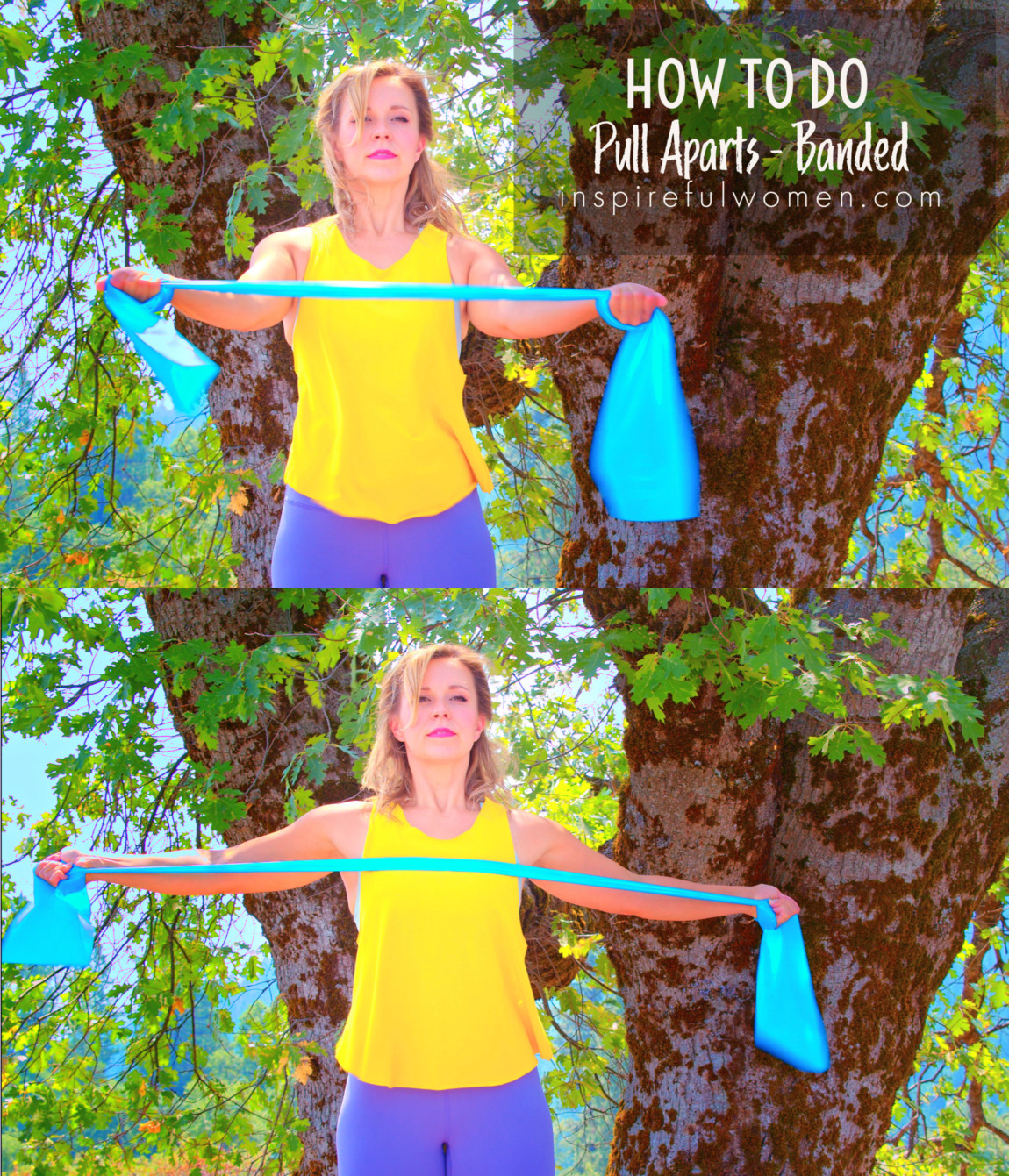
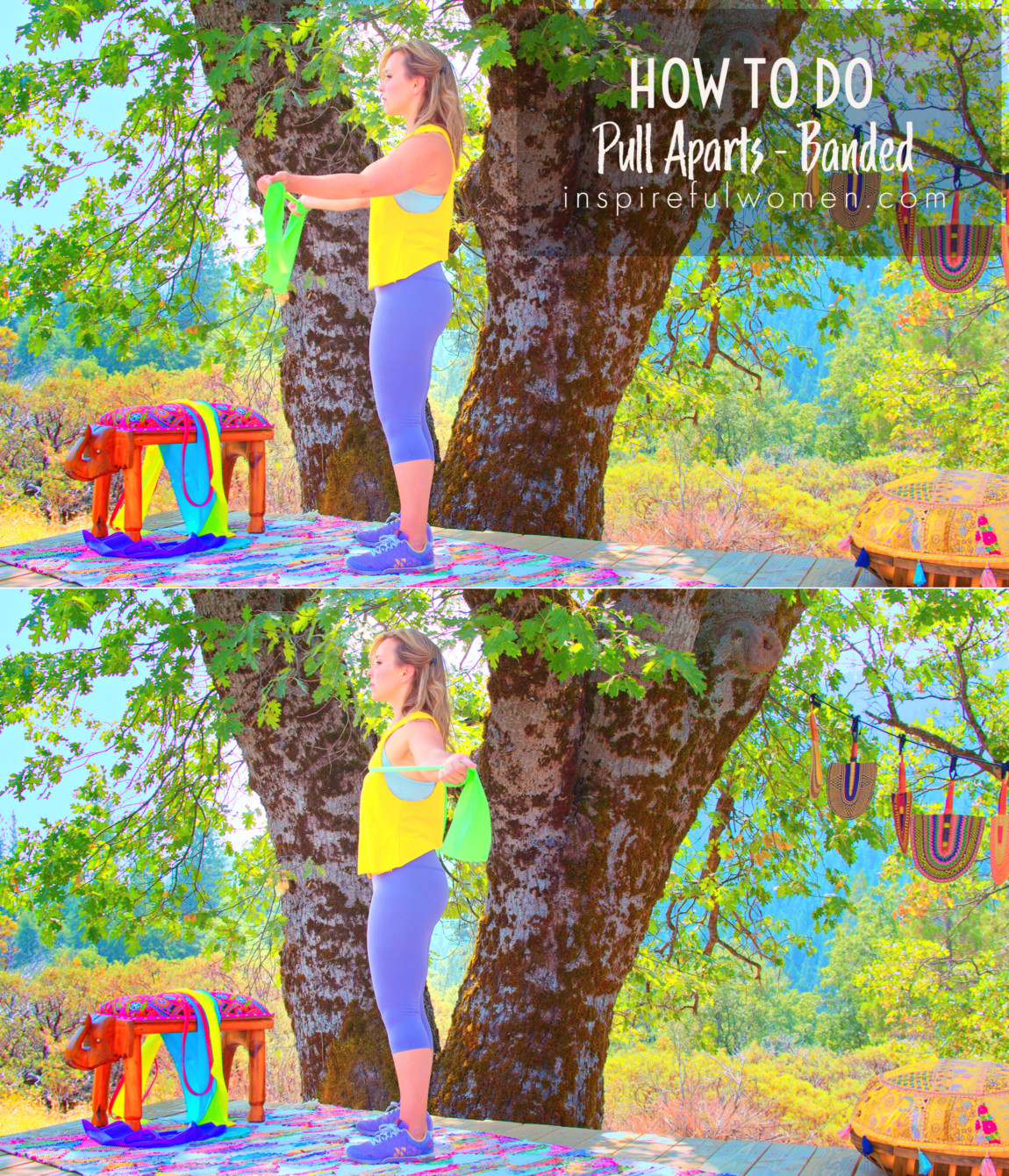
COMMON MISTAKES
COMMON MISTAKES
WHAT TO AVOID WITH BAND PULL APARTS
KEY TIP:
Guess what? Good news! Many avoids are the same for most movements. Once you learn the basics, there's really only a few extra avoids for each individual movement.
1. Avoid Arching Low Back
AVOID: Avoid arching your lumbar spine.
WHAT TO DO:
- Maintain a neutral spine position to prevent low back joint injury, muscle strain, or damage over time.
- Pressure or discomfort in your low back
- Troubleshooting suggested fixes
- Poor core strength: activate your abdominal muscles, or choose a position with more support.

2. Avoid Moving Into Pain
AVOID: Avoid moving into pain.
WHAT TO DO:
- Try stopping right at the edge of pain and holding the position. This will help strengthen the muscles that control the stability and control of the shoulder joint.
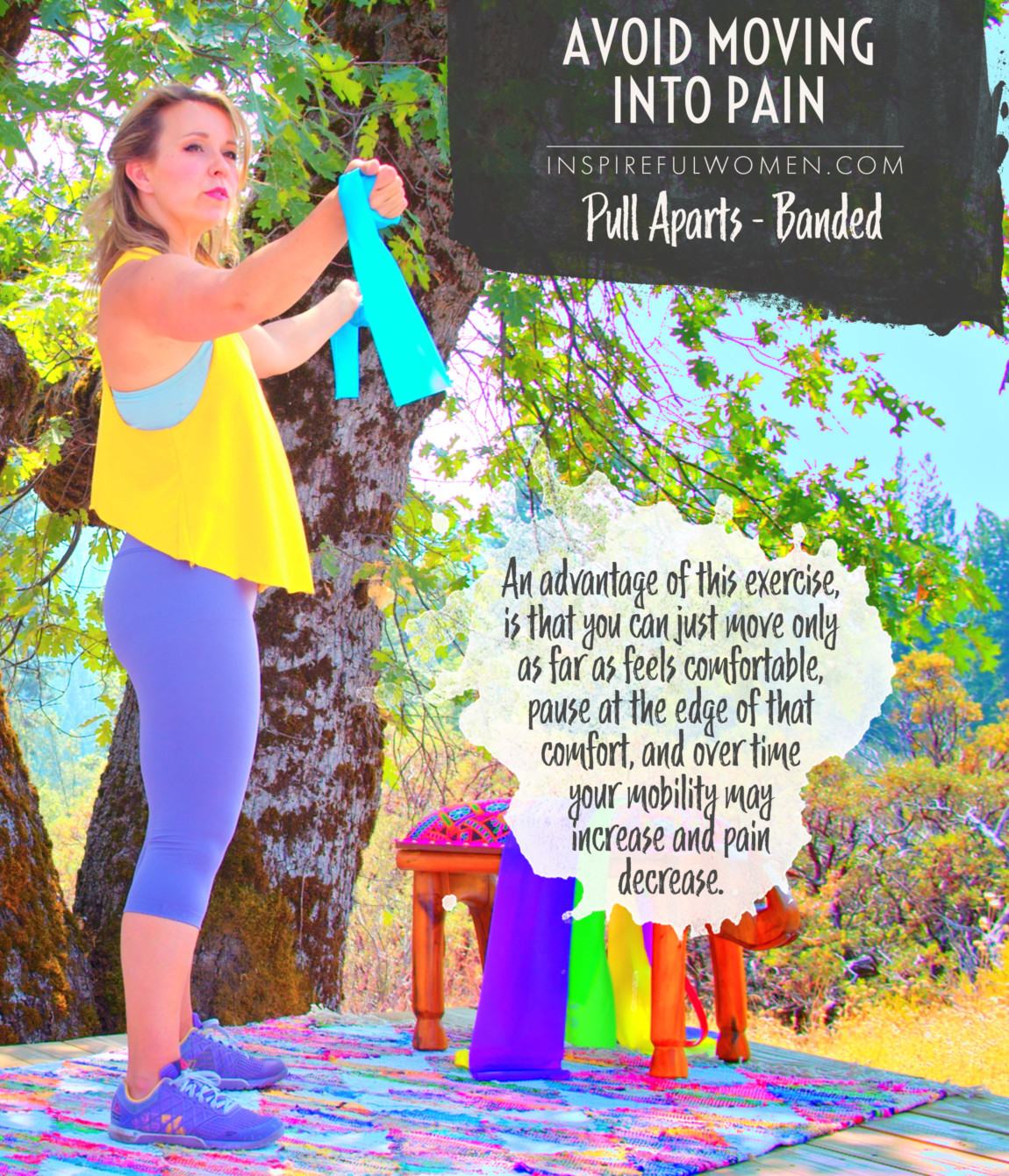
3. Avoid Too Much Resistance
AVOID: Avoid using too much resistance
WHY NOT?
- The goal is to work the muscles for endurance through large ranges of motion.
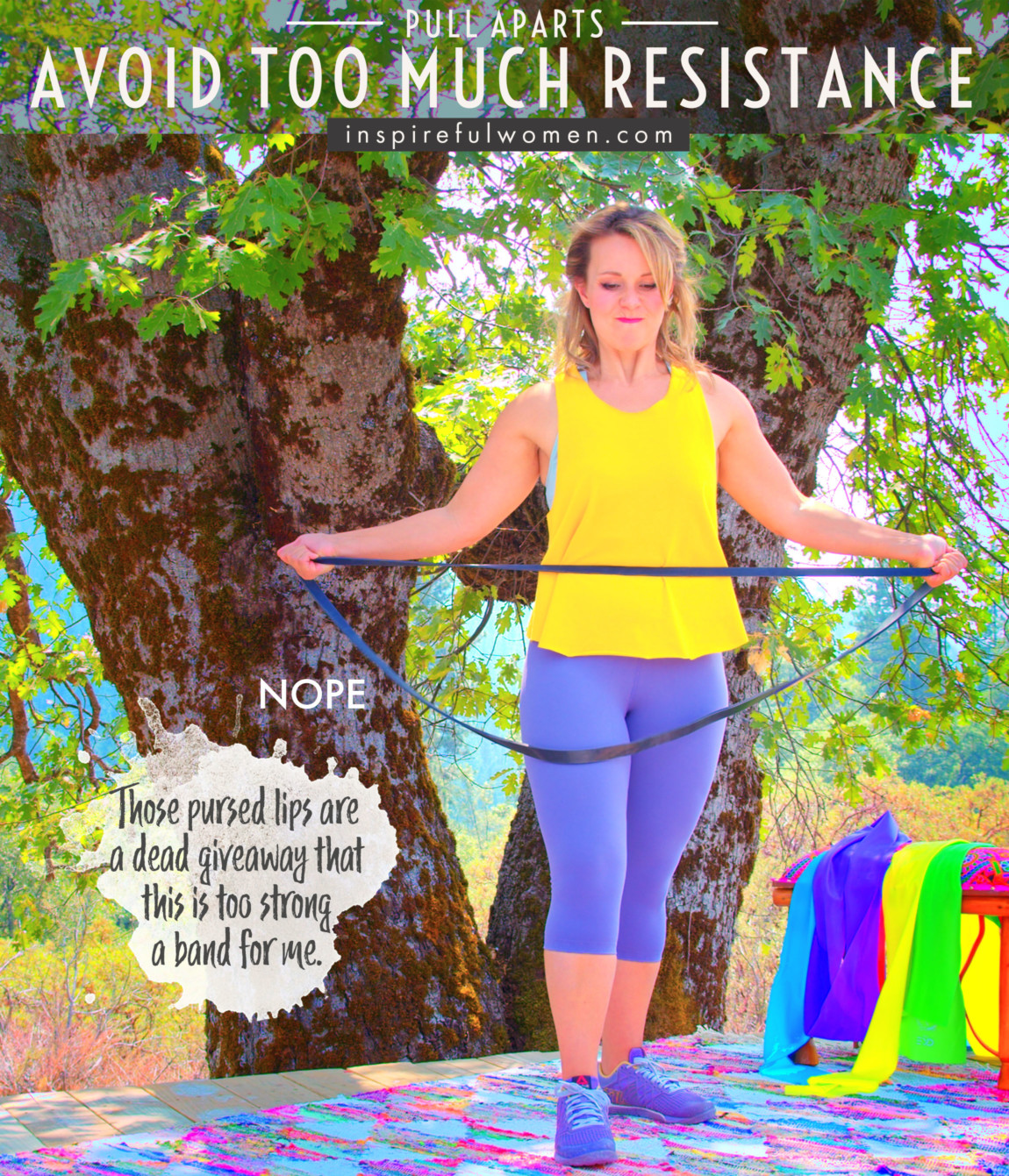
4. Avoid Bending Wrists
AVOID: Bending or moving through your wrists.
WHAT TO DO:
- It is easy to let the band pull your wrist inward. Make sure that your wrists are straight throughout the exercise.
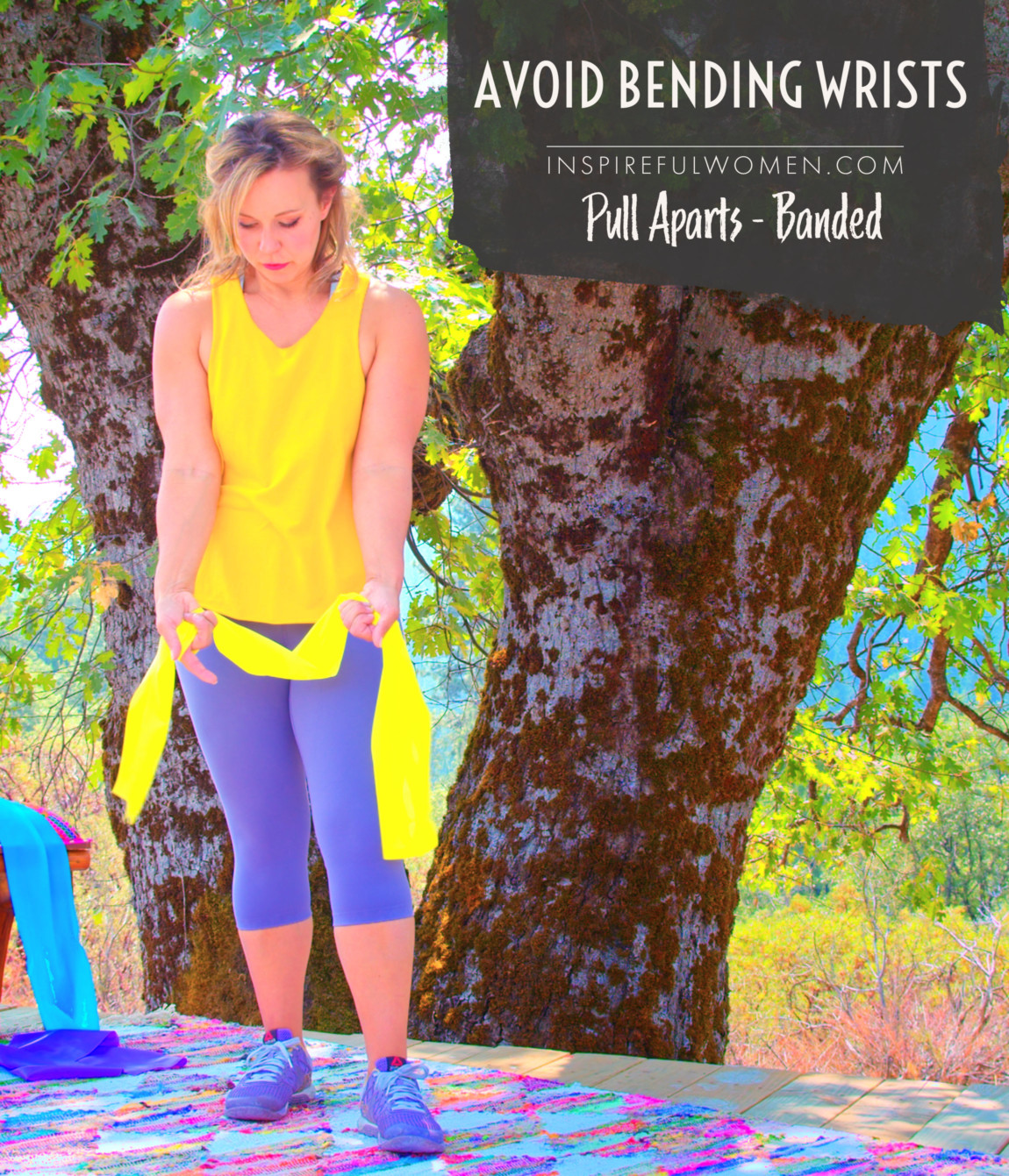
5. Avoid Locking Knees
AVOID: Avoid locking your knees
WHY NOT?
- Locking your knees will put your low back in extension.
WHAT TO DO:
- The goal is to work the trunk muscles in a neutral spine position (the latissimus crosses the low back).
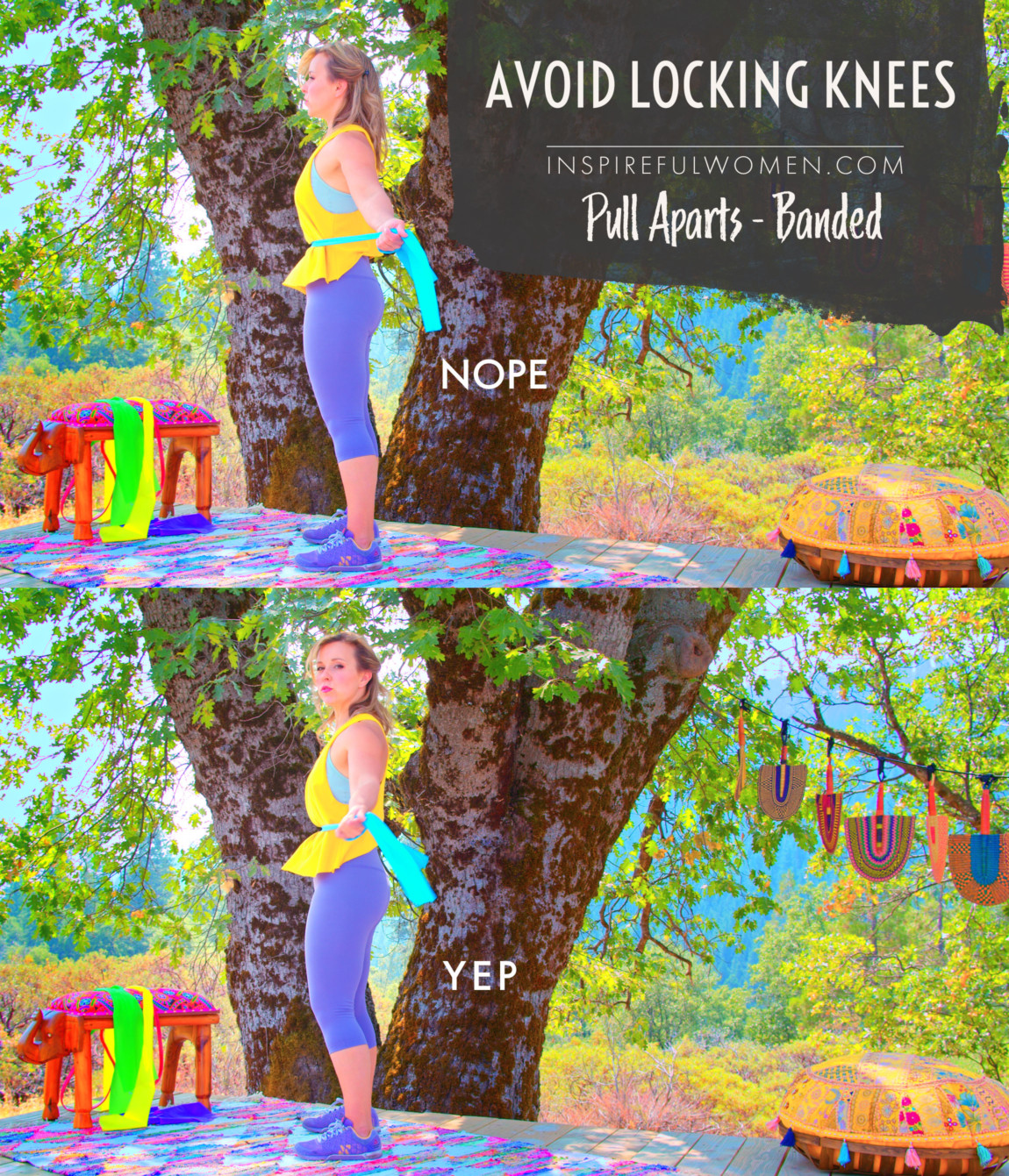
6. Avoid Tensing Neck Muscles
AVOID: Tightening your neck muscles
WHY NOT?
- This can lead to neck strain, injury or damage over time.
- You may feel neck discomfort, find that you are pressing down with your head, or gripping with your neck muscles.
- Prevents you from using the correct muscles.
WHAT TO DO:
- Gripping the neck muscles in an attempt to stabilize the shoulders: relax the neck and activate the core muscles more, activate the scapular stabilizers in retraction and depression.
- The neck should be neutral and relaxed, with space between the earlobe and top of shoulder.

VARIATIONS
VARIATIONS
VARIATIONS OF BAND PULL APARTS
Change Muscle Activation
Adjust Targeted Muscle in Band Pull Aparts
Muscles working at each level:
Hands at belly button level: The shoulder blades will be rotated downward: pec minor and major, rhomboids, levator scapula, latissimus dorsi.
Hands at chest height: The shoulder blades will be fairly neutral - no rotation: mid trapezius and rhomboids.
Higher arms: As you lift your arms up higher the scapular rotates upward using the serratus anterior (upward rotation above 90 degrees of abduction), and the upper and lower trapezius.
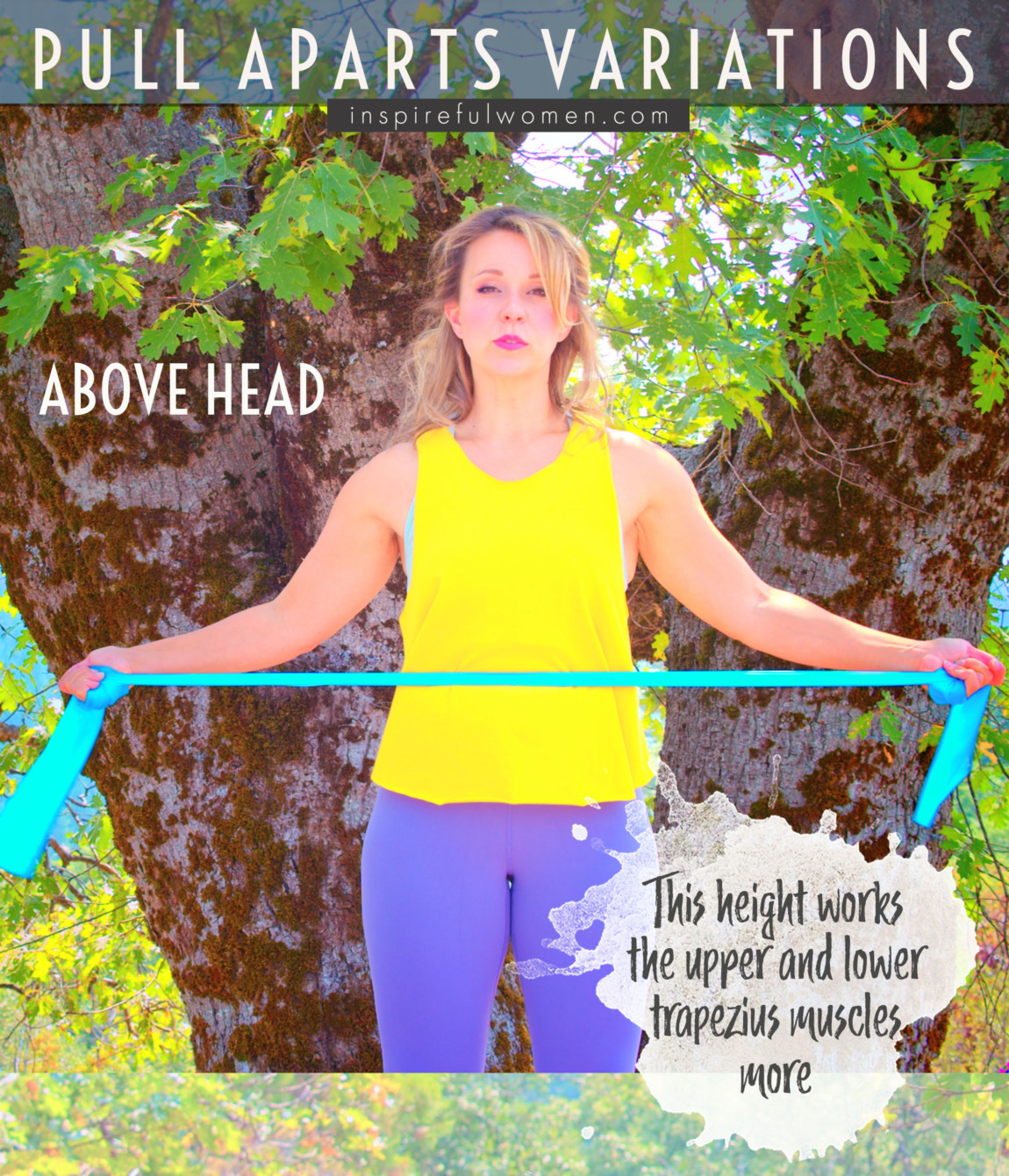
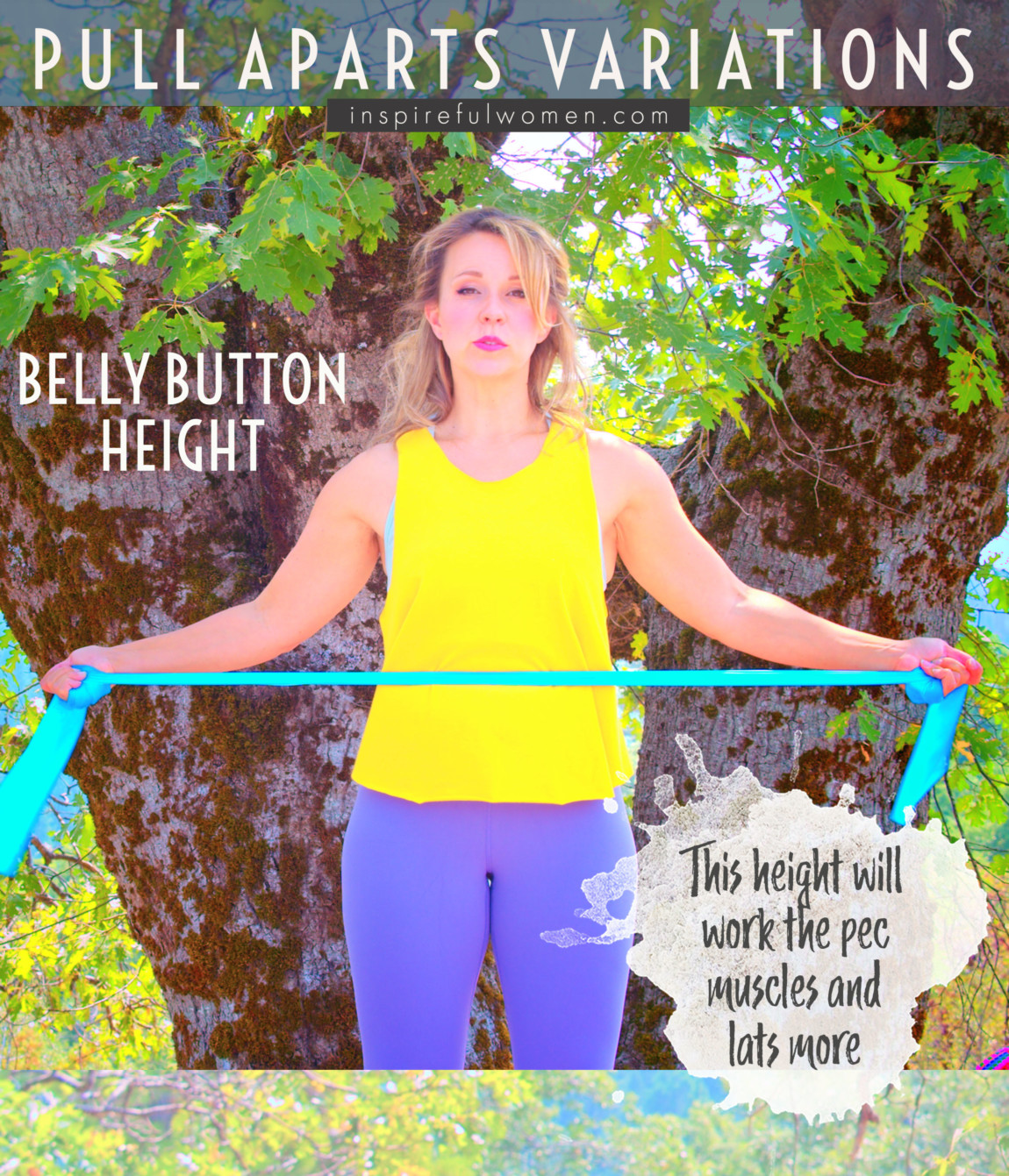


Hand Position Options
Hand Position Options Banded Pull Aparts
The hand can be held with the thumb pointing upwards (neutral grip) – will increase the activity of the the side of your shoulder muscle (called the medial deltoid) and decrease the activity of the back of the shoulder of the muscles (the posterior deltoid, infraspinatus and teres minor).
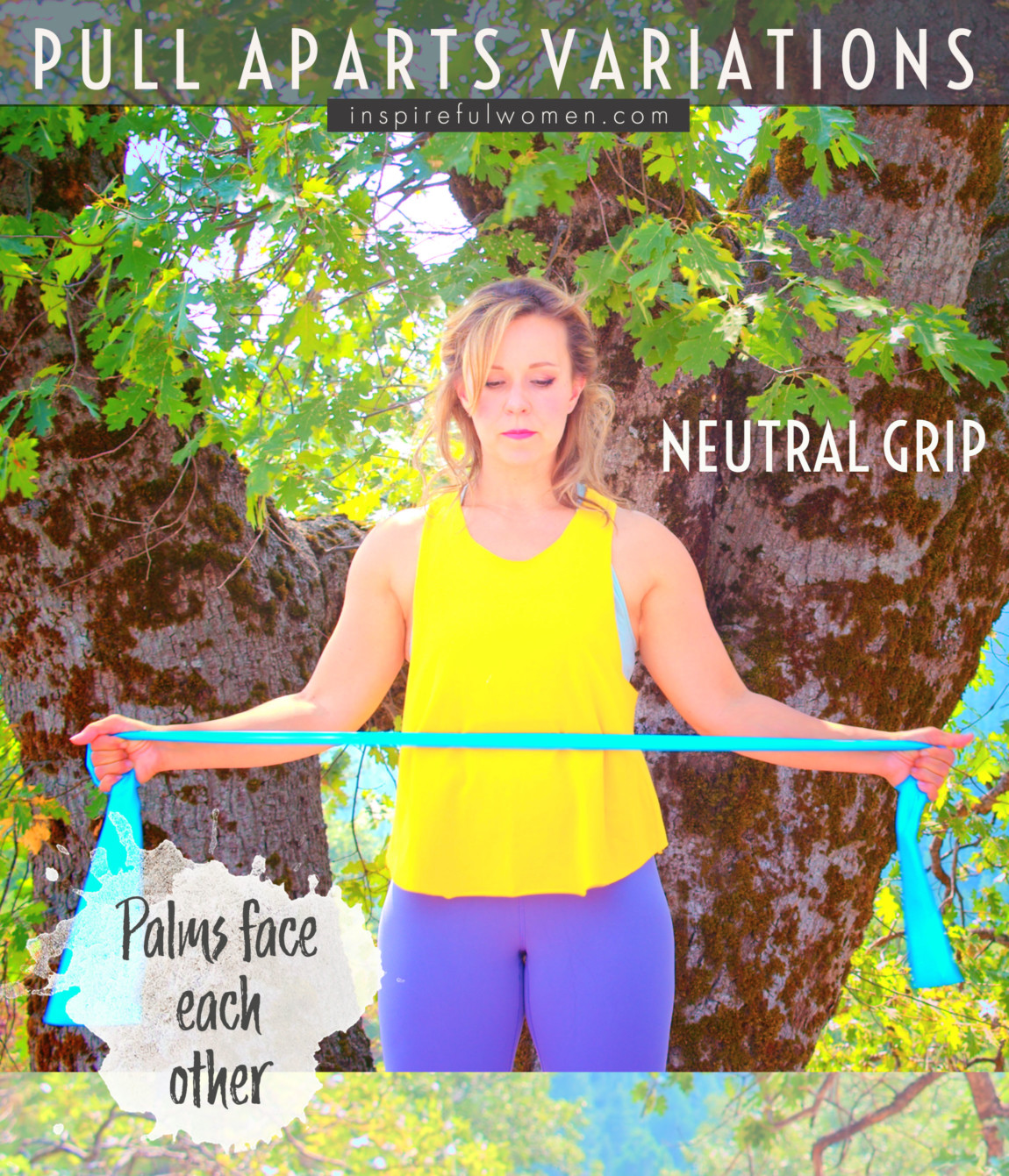
Variety in Hand Position
Variety in Arm Position
The level that the arms are held can be changed. All of the reps can be done at one level, and any level between belly button and your eyes is fine to do. The muscles that are worked will change based on how high the arms are held. You can even use this as a mini self-assessment and go through the range moving up one inch each rep, if you find an area that is sore, stiff or feels weak then you could work in that range for a few pulses.
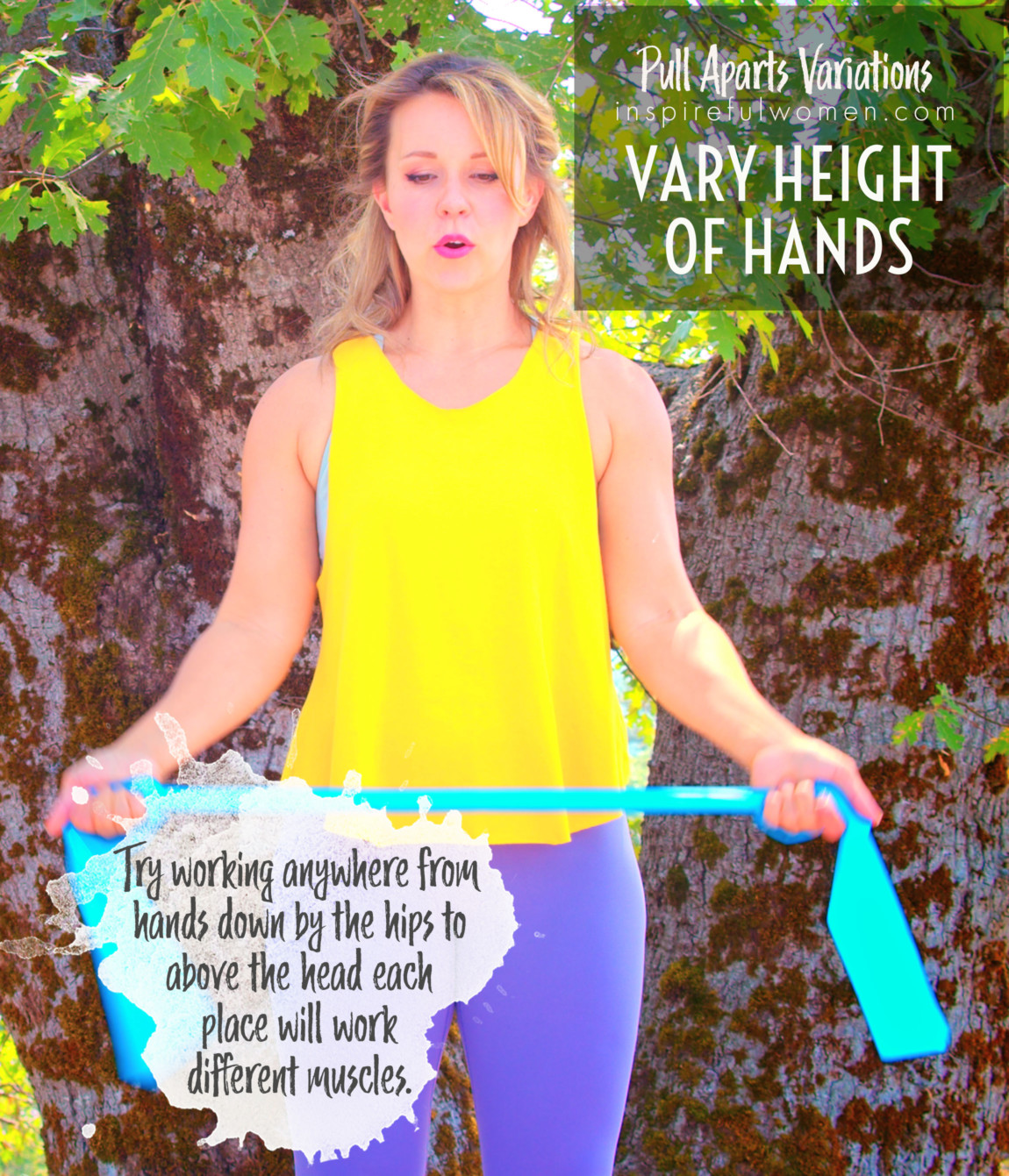
MAKE IT HARDER
HARDER
MAKING THE BAND PULL APARTS MORE CHALLENGING
Heavier Band
Heavier Band
Heavier band but maintain range. Do not increase the resistance to the point of having to engage your upper trap or neck muscles.
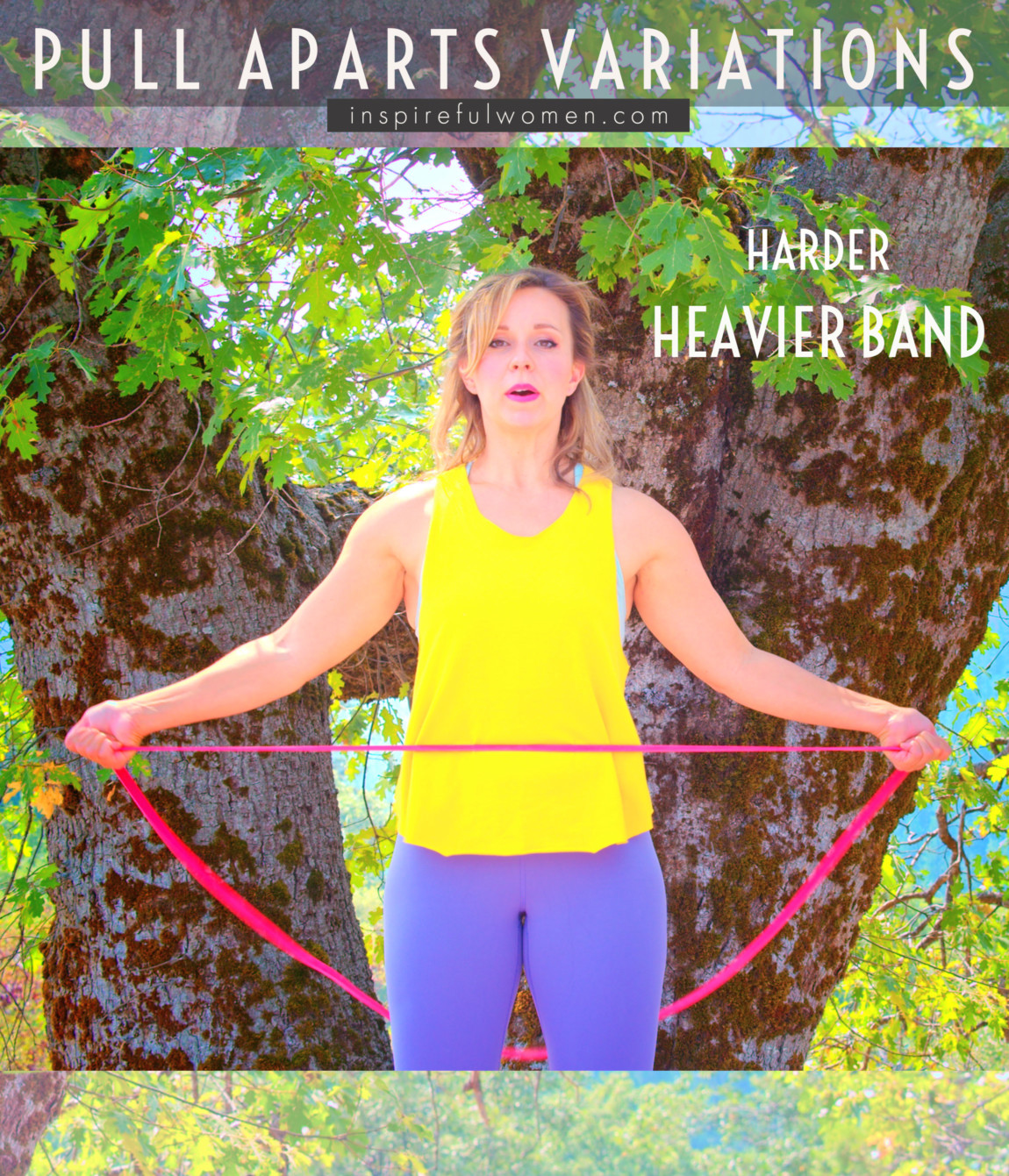
Iso Hold
Isometric Hold Pull Aparts
Hold at the end of the range for 3-5 seconds (for each rep)
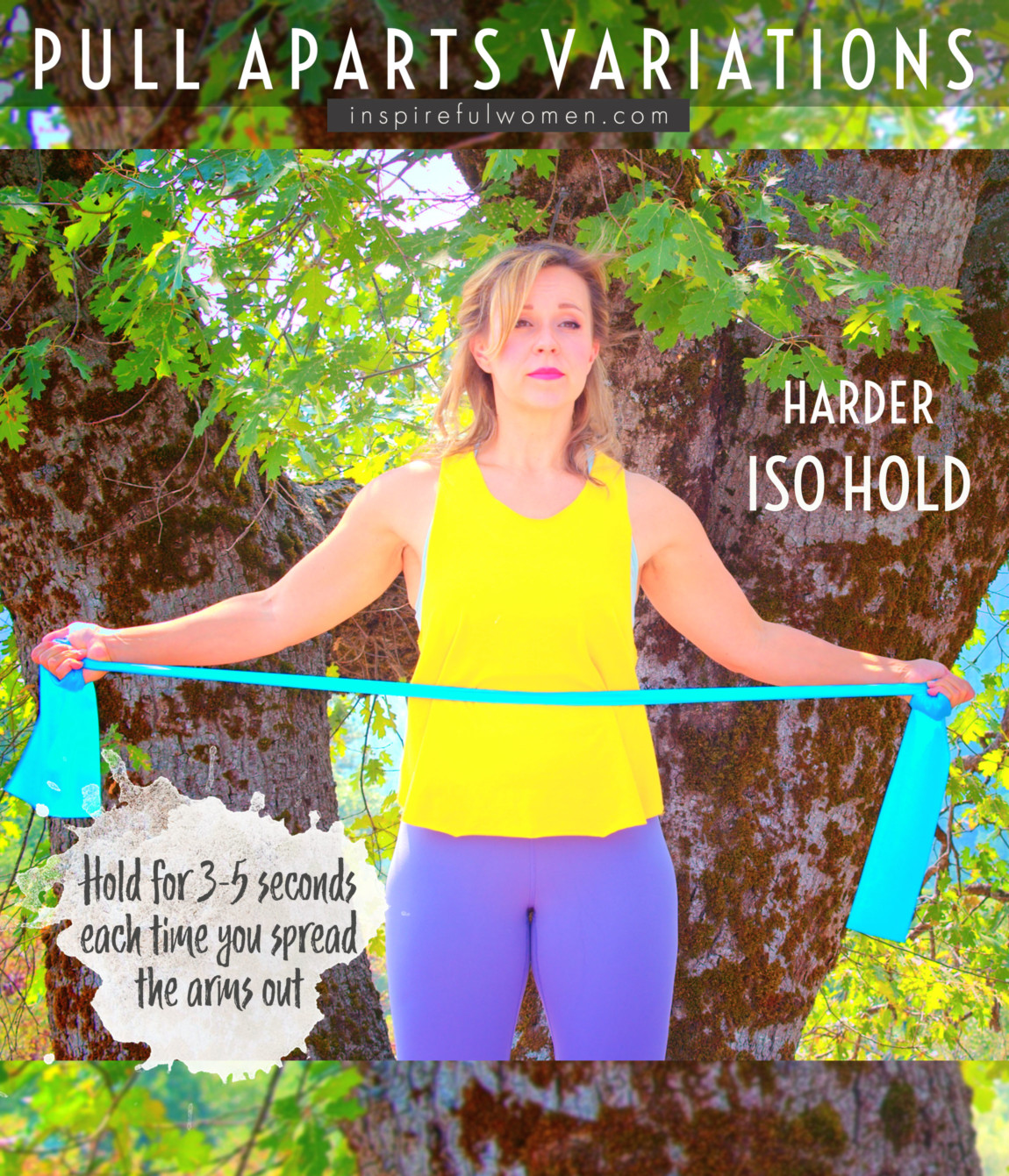
Pulses
Pulse Banded Pull Aparts
Pulse 5 times at the end of the range (for each rep)
Single Arm
Single Arm Pull Aparts
Hold one arm still (in the starting position) and move the other arm out to the side. The “non-working” arm will act as the anchor for the band. The “non-working” will be working to hold the arm still against the pull of the other arm. Hold the torso - hips and shoulders squared to the front. This will also increase the activity of the internal and external obliques that control spinal rotation, and the quadratus lumborum to prevent side bending
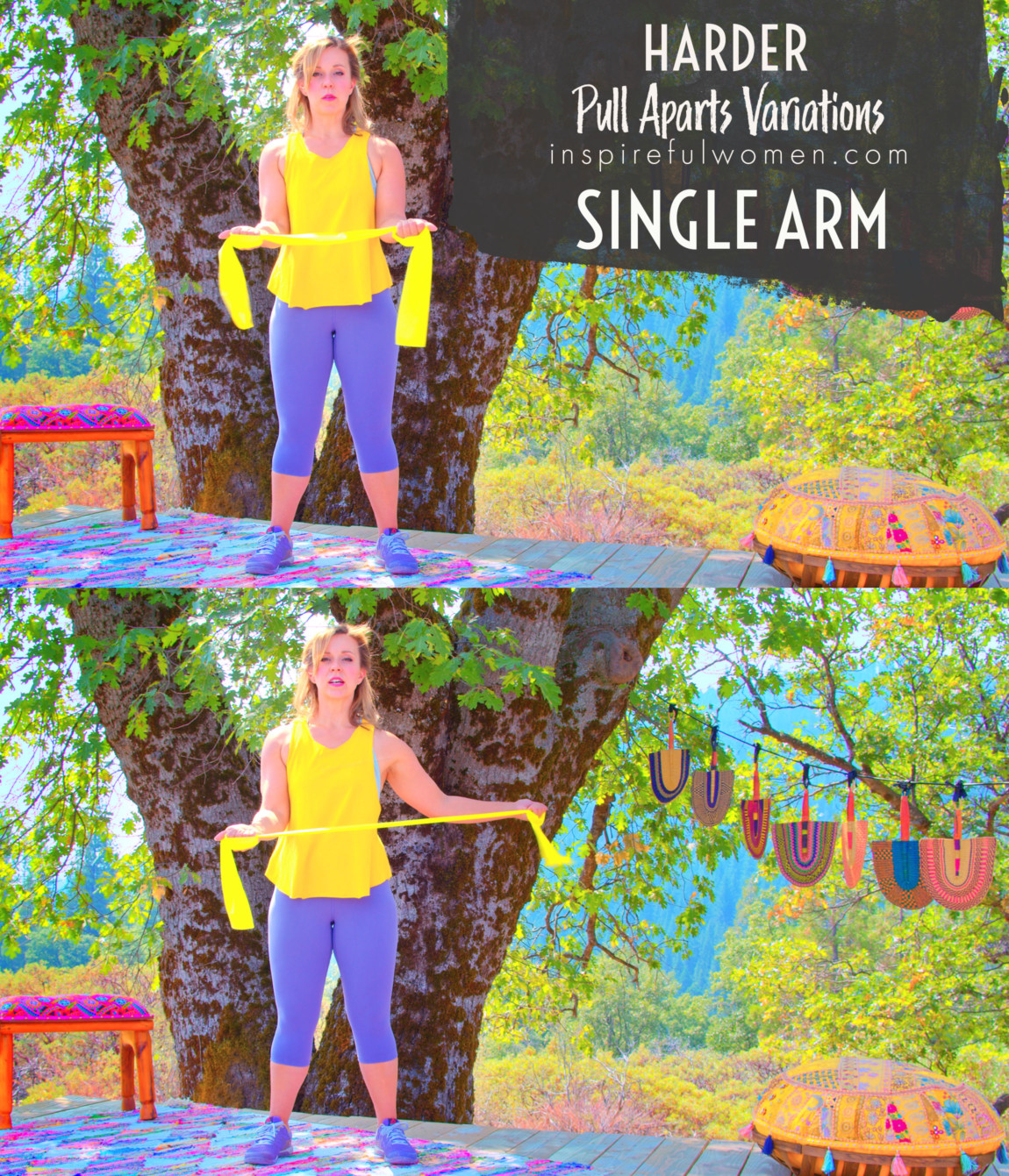
DUMBBELL
Dumbbell Pull Aparts
Using light dumbbells (1-5lbs) instead of elastic band will increase the work done by the deltoids and may decrease the amount of work done by the smaller stabilizing muscles of the shoulder joint and shoulder blade muscles.
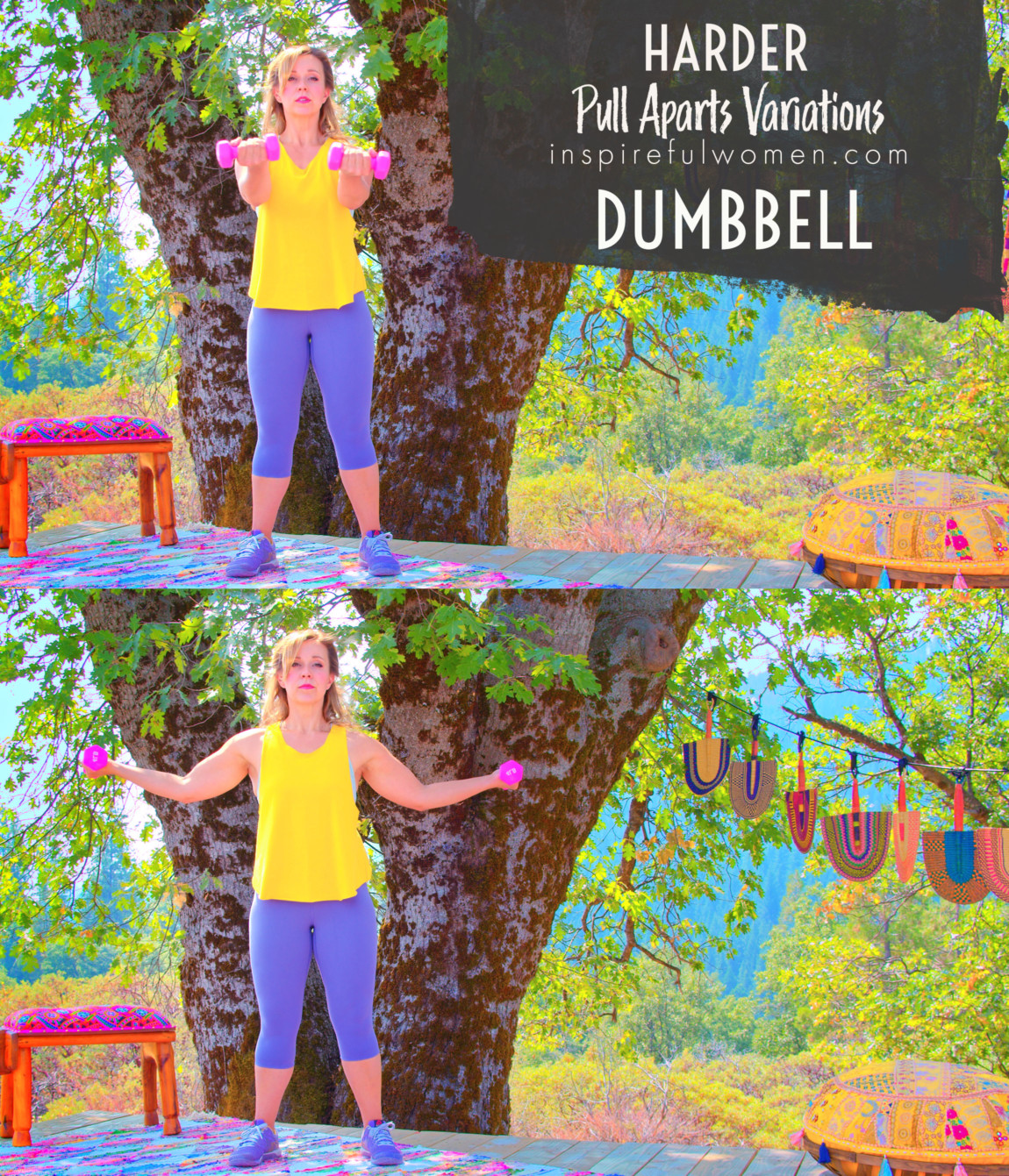
MAKE IT EASIER
EASIER
MAKE THE BAND PULL APARTS MORE DOABLE
less reps or no resistance
less reps or no resistance
Stepping out into a wider stance will give you a more stable base to work off of. Your core muscles will not need to work as hard to stabilize.

Seated on a chair
Seated Pull aparts
This can be done seated on a chair. Make sure that you are sitting upright towards the edge of the seat so the range of movement of the arms and shoulder blades is not affected. It may decrease the amount of work your core muscles are doing.
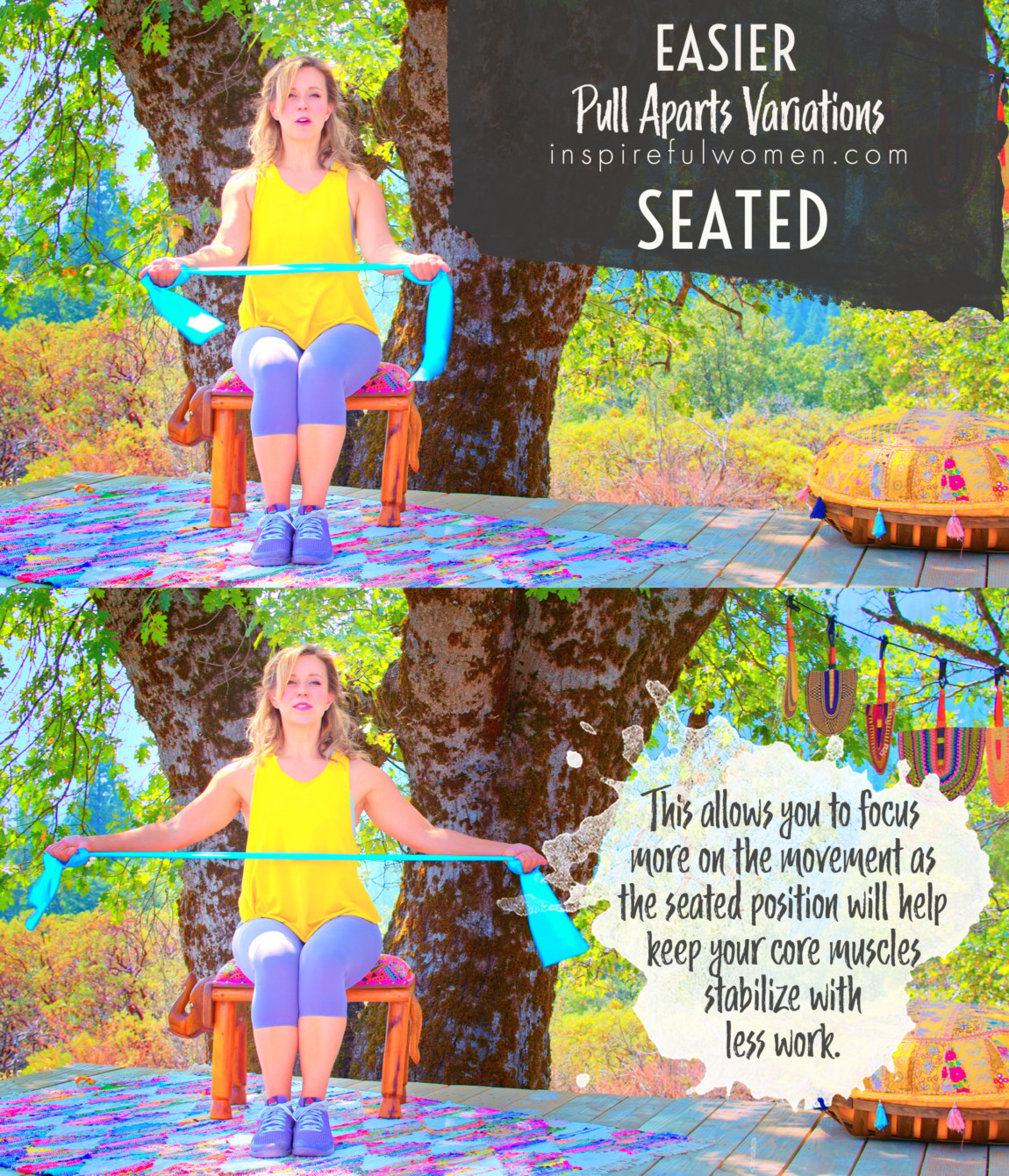
stability ball Seated
Seated on a Stability Ball Pull Aparts
This can be done seated on a stability ball. Make sure that the spine is in a neutral position and the trunk remains very still. May work the core muscles more than sitting on a chair but less than in standing.
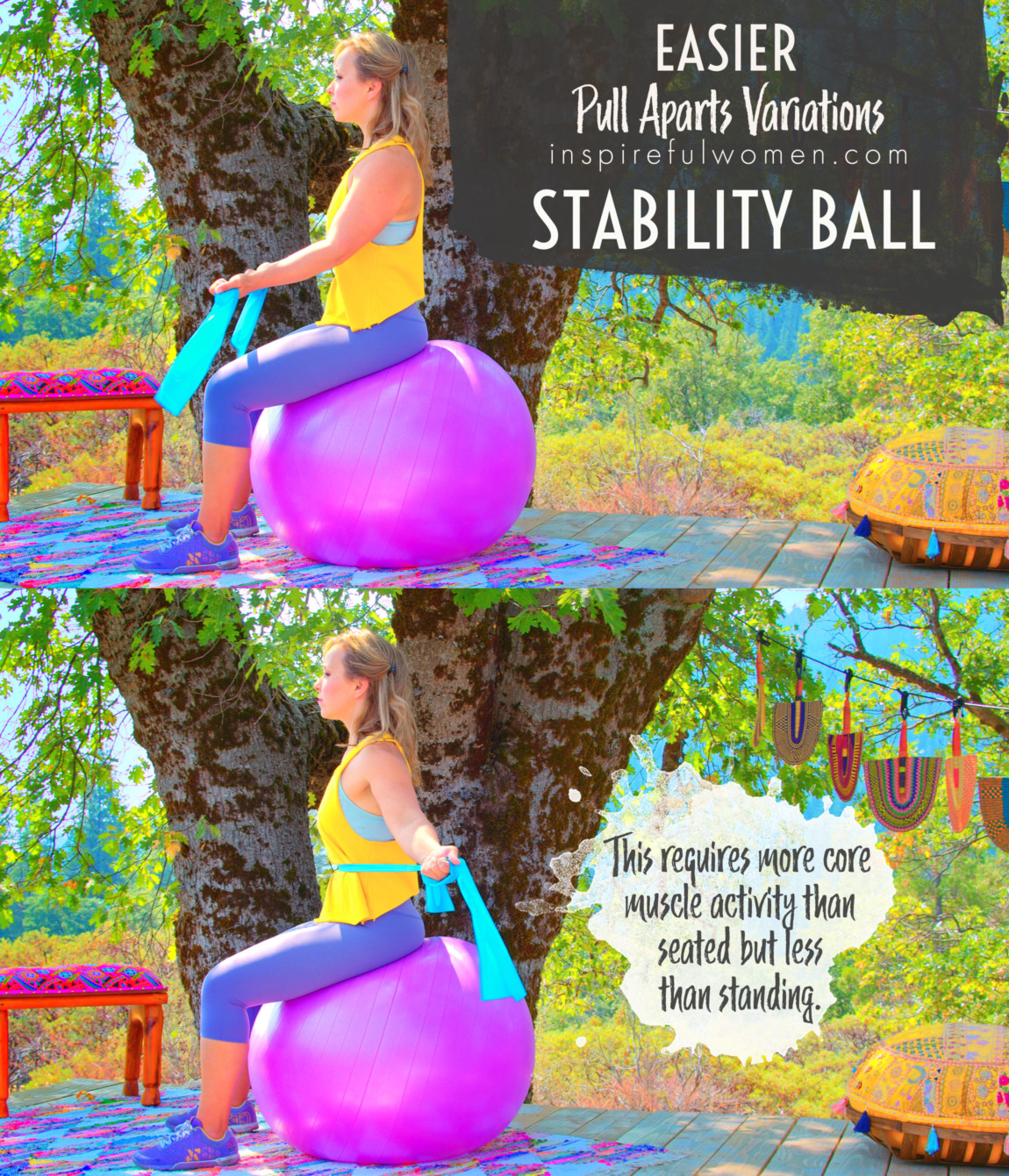
Limit ROM
Limit Range of motion pull aparts
Limit the range of the arm movement as needed. You can limit how far you move your arms back and/or how high you lift your arms – increase as your strength improves.
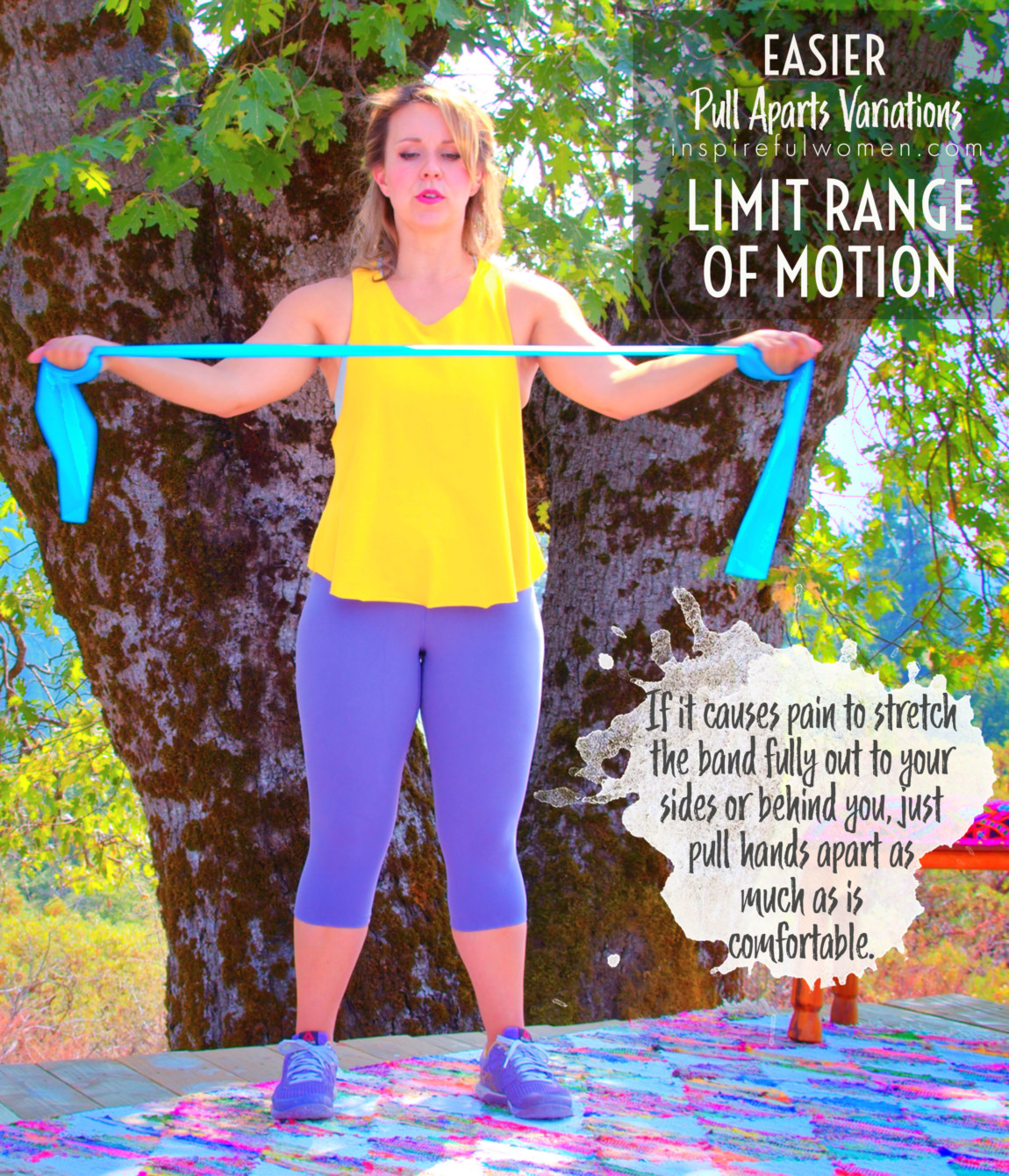
Practice Scapula Movement
Practice Moving Shoulder Blades
Some people have a hard time learning how to move their shoulder blades. Beginning with simple shoulder blade squeezes (retraction of the scapula - shoulder blades back and together), shoulder shrugs (moving the shoulder blades all the way up and then actively pulling them all the way down) and shoulder rolls (more like a half circle: shoulder blades are moved upwards, backwards, downwards and back to neutral – on in the backward direction, never forward because we already tend to hold our shoulders forward and internally rotated) can help people learn how to control the movement of their shoulder blades.
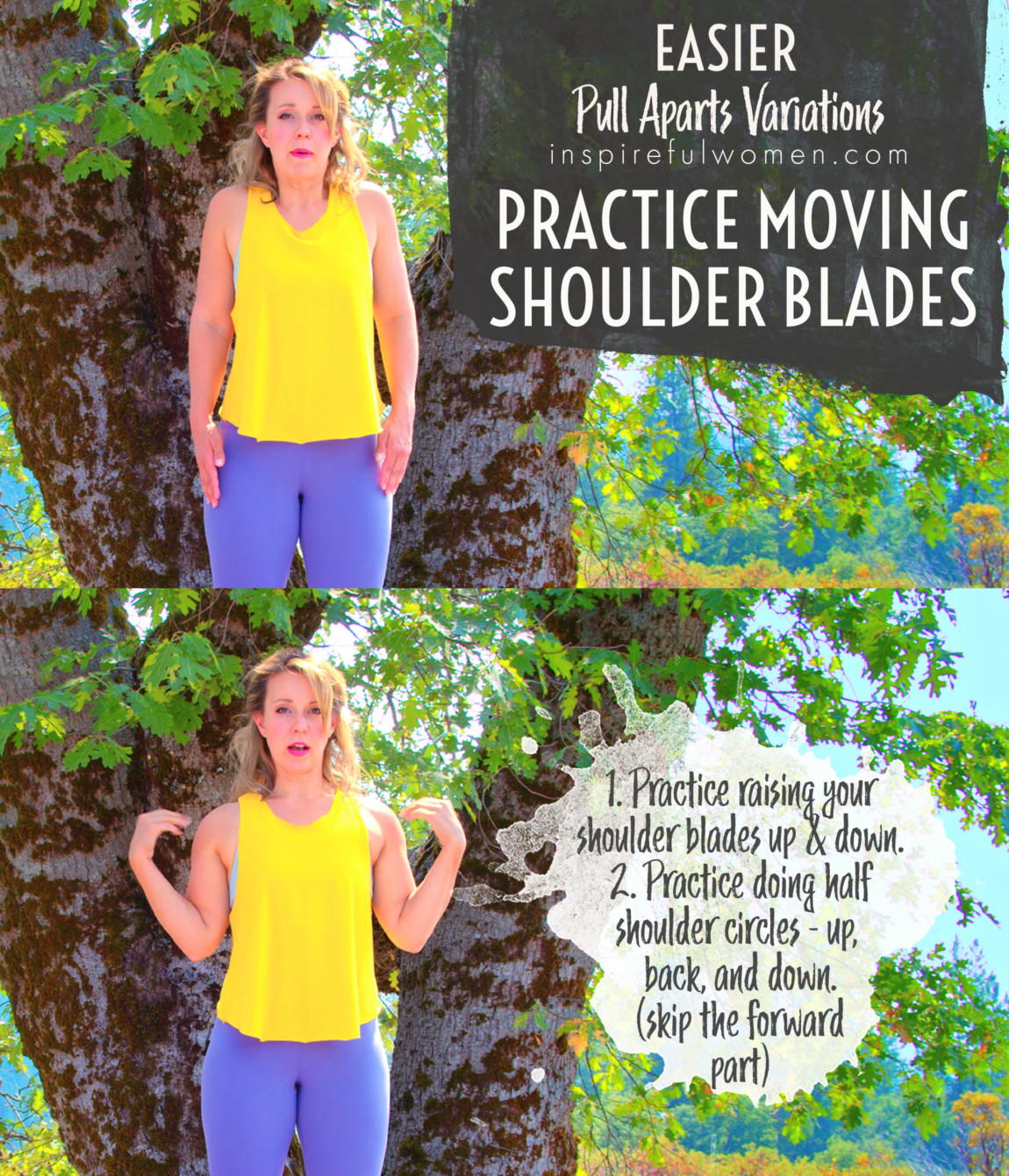
SCIENCY STUFF
SCIENCY STUFF
SPIFFILICIOUS FACTS ABOUT MUSCLES & MOVES
WORK MUSCLES THAT COORDINATE OUR SHOULDER BLADE & ARM MOVEMENT
Banded pull aparts works the muscles of the shoulder region that are used in most any activity that involves the use of the arms, including reaching, pulling, lifting, working overhead, and simple daily activities like getting dressed and washing your hair.
The most important function of these muscles is to control the interplay between the movements of the shoulder blade and the arm during all arm movements.
When the larger shoulder muscles – deltoids, biceps, triceps, pecs are strengthened in isolation (separately from other small muscles nearby) the muscles that move the shoulder blade and stabilize the shoulder joint are not strong enough to support the movements of the arm. This results in dysfunctional movement patterns and potential injuries over time, such as tears, tendinopathies (when tissues that connect muscle to the bone get inflamed, which can take several months with proper physical therapy to heal), and degenerative changes in the shoulder joints, or spine.
SUPPORTS UPRIGHT POSTURE
These muscles are also used to support the upright posture. Features of poor posture include rounded back, and rounded and internally rotated shoulders. Poor posture is a primary cause of neck, shoulder, and low back pain and can contribute to carpal tunnel syndrome. All of the nerves that pass through the tunnel exit the spinal cord through the cervical spine.
Poor posture, especially cervical extension (your neck bent backward) that is common with desk jobs/computer use, can compress the nerve roots as they exit between each pair of vertebrae. The nerve becomes irritated and hypersensitive, so minimal amounts of wrist use can further irritate the nerve and result in carpal tunnel symptoms. This is not always the case - not all carpal tunnel syndrome has cervical involvement, but in the clinic, we (Carol the physical therapist & her peeps) always address posture with carpal tunnel patients in order to keep the nerve as healthy as possible from the neck to the hand.
This exercise strengthens and stretches (the pecs) the muscles to promote holding the shoulders back and externally rotated.
ALLLL MUSCLES & WHEN
ALL MUSCLES WORKING & WHEN DURING THE Resistance BAND PULL APARTS
To begin the scapula is depressed (pectoralis minor, subclavius, latissimus dorsi, lower trap, serratus) and rotated downward (pec minor and major, rhomboids, levator scapula, latissimus dorsi), the muscles work isometrically to stabilize the shoulder joint. As the hands pull apart, the lower trapezius, rhomboids, and latissimus dorsi contract concentrically to move the shoulder blades together (scapular retraction).
The prime movers of the arm are the deltoids, with the posterior deltoid becoming more active as the arms move further backwards. The hands are held isometrically in external rotation (of the humerus/shoulder joint – hands upward) by the infraspinatus, teres minor, posterior deltoid.
The arms are lifted with the next set of reps (arms are lifting upwards – to chest height and then face height or higher) to activate the muscles that rotate the scapular upward (serratus anterior, trapezius, and serratus anterior).
Muscles working at each level:
Hands at belly button level: the shoulder blades will be rotated downward: pec minor and major, rhomboids, levator scapula, latissimus dorsi.
Hands at chest height: the shoulder blades will be fairly neutral - no rotation: mid trapezius and rhomboids.
Higher arms: As you lift your arms up higher the scapular rotates upward using the serratus anterior (upward rotation above 90 degrees of abduction), and the upper and lower trapezius.
PIN IT FOR LATER!

